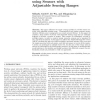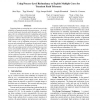101 search results - page 3 / 21 » Use of parallel computers in rational design of redundant se... |
ISPAN
2005
IEEE
13 years 11 months ago
2005
IEEE
We propose and evaluate wireless sensor routing algorithms designed to extend the lifetime of a heterogeneous wireless sensor network. The network is heterogeneous in the sensors‚...
IJSNET
2006
13 years 5 months ago
2006
Abstract: This paper addresses the target coverage problem in wireless sensor networks with adjustable sensing range. Communication and sensing consume energy, therefore efficient ...
SIGCSE
2006
ACM
13 years 11 months ago
2006
ACM
Target tracking is one of the most important applications of wireless sensor networks. Optimized computation and energy dissipation are critical requirements to maximize the lifet...
IPSN
2010
Springer
14 years 17 days ago
2010
Springer
Shared sensing infrastructures that allow multiple applications to share deployed sensors are emerging and Internet protocol based access for such sensors has already been prototy...
DSN
2007
IEEE
14 years 2 days ago
2007
IEEE
Transient faults are emerging as a critical concern in the reliability of general-purpose microprocessors. As architectural trends point towards multi-threaded multi-core designs,...


